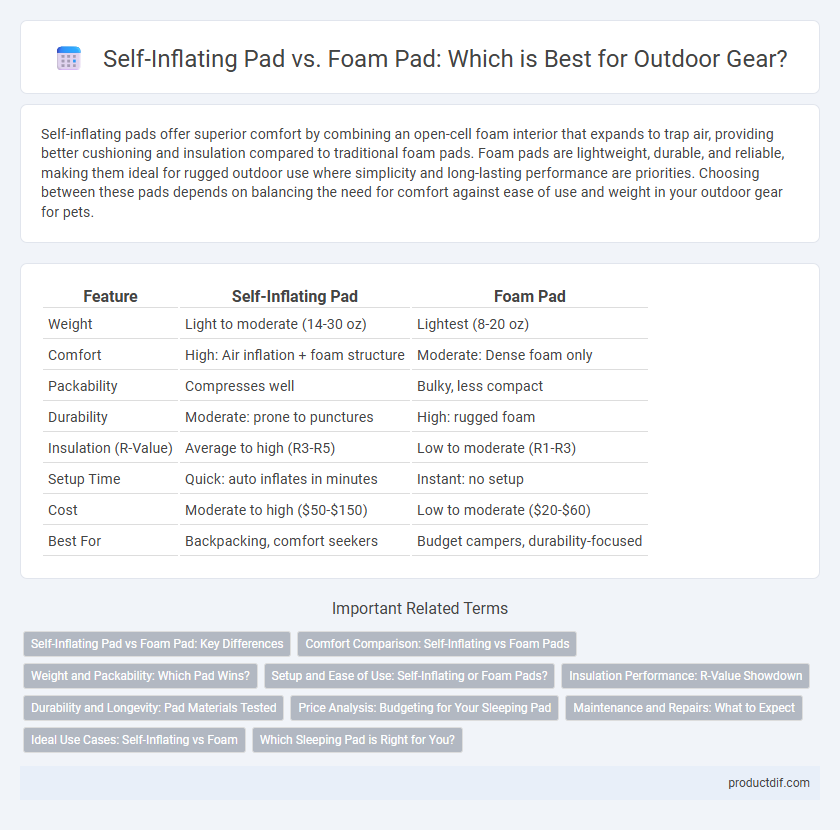Self-inflating pads offer superior comfort by combining an open-cell foam interior that expands to trap air, providing better cushioning and insulation compared to traditional foam pads. Foam pads are lightweight, durable, and reliable, making them ideal for rugged outdoor use where simplicity and long-lasting performance are priorities. Choosing between these pads depends on balancing the need for comfort against ease of use and weight in your outdoor gear for pets.
Table of Comparison
| Feature | Self-Inflating Pad | Foam Pad |
|---|---|---|
| Weight | Light to moderate (14-30 oz) | Lightest (8-20 oz) |
| Comfort | High: Air inflation + foam structure | Moderate: Dense foam only |
| Packability | Compresses well | Bulky, less compact |
| Durability | Moderate: prone to punctures | High: rugged foam |
| Insulation (R-Value) | Average to high (R3-R5) | Low to moderate (R1-R3) |
| Setup Time | Quick: auto inflates in minutes | Instant: no setup |
| Cost | Moderate to high ($50-$150) | Low to moderate ($20-$60) |
| Best For | Backpacking, comfort seekers | Budget campers, durability-focused |
Self-Inflating Pad vs Foam Pad: Key Differences
Self-inflating pads offer superior comfort and insulation by combining open-cell foam with air, providing customizable firmness and better heat retention, ideal for cold-weather camping. Foam pads are lightweight, durable, and affordable, delivering consistent cushioning without the risk of punctures or deflation, making them suitable for rugged terrain and budget-conscious adventurers. Choosing between self-inflating and foam pads depends on factors like weight, comfort, durability, and insulation needs during outdoor activities.
Comfort Comparison: Self-Inflating vs Foam Pads
Self-inflating pads provide superior comfort through adjustable firmness and better insulation, ideal for uneven or cold terrain. Foam pads offer durable, lightweight support with consistent cushioning but lack the customizable thickness of self-inflating models. The choice depends on personal preference for comfort levels versus weight and simplicity.
Weight and Packability: Which Pad Wins?
Self-inflating pads offer superior packability due to their ability to compress into a compact size, making them ideal for lightweight backpacking. Foam pads are generally lighter in weight but bulkier when packed, which can be less convenient for space-conscious campers. For those prioritizing minimal pack size and moderate weight, self-inflating pads typically provide the best balance between weight and packability.
Setup and Ease of Use: Self-Inflating or Foam Pads?
Self-inflating pads offer quick and effortless setup by automatically inflating with a simple valve opening, making them ideal for campers seeking convenience and comfort. Foam pads require manual placement and packing but provide immediate usability without inflation time, enhancing reliability in cold or wet conditions. Choosing between self-inflating and foam pads depends on prioritizing rapid setup versus durable simplicity for outdoor gear enthusiasts.
Insulation Performance: R-Value Showdown
Self-inflating pads typically offer higher R-values ranging from 3 to 7, providing superior insulation by combining foam cores with air, which effectively traps heat. Foam pads usually have lower R-values, generally between 1.5 and 4, but maintain insulation even when punctured or wet due to their closed-cell structure. Choosing a self-inflating pad maximizes warmth on cold nights, while foam pads deliver consistent, durable insulation in rugged, wet conditions.
Durability and Longevity: Pad Materials Tested
Self-inflating pads feature closed-cell foam cores encased in durable, weather-resistant nylon, offering excellent resilience against punctures and abrasion over multiple uses. Foam pads, made from dense EVA or open-cell foam, provide rugged longevity with minimal maintenance but may compress over time, reducing comfort and insulation. Comparative tests show self-inflating pads maintain structural integrity longer in harsh outdoor conditions, while foam pads deliver consistent durability in rocky or uneven terrain.
Price Analysis: Budgeting for Your Sleeping Pad
Self-inflating pads generally cost more than foam pads due to their advanced air valve systems and added comfort features, making them a worthwhile investment for frequent campers seeking enhanced insulation and support. Foam pads are the most budget-friendly option, offering durability and lightweight convenience at a fraction of the price, ideal for backpackers prioritizing cost over comfort. When budgeting for your sleeping pad, balance initial cost against long-term usage and comfort needs to select the best value outdoor gear for restful sleep.
Maintenance and Repairs: What to Expect
Self-inflating pads require occasional valve maintenance and patch repairs for punctures, which can be easily fixed with repair kits available from outdoor gear brands. Foam pads offer minimal maintenance due to their solid construction, but damaged foam may compress over time, reducing comfort and insulation. Expect self-inflating pads to need more attention to ensure inflation consistency, while foam pads provide durability with fewer repair concerns.
Ideal Use Cases: Self-Inflating vs Foam
Self-inflating pads are ideal for backpackers seeking lightweight, compact gear with enhanced comfort and thermal insulation during multi-day trips or cold-weather camping. Foam pads excel in durability, affordability, and quick drying, making them perfect for rugged use, short hikes, or situations where weight and pack size are less critical. Choosing between the two depends on specific outdoor activities, terrain, and climate conditions, balancing comfort with portability and resilience.
Which Sleeping Pad is Right for You?
Self-inflating pads offer a balance of comfort and insulation with their foam core and air chamber combination, providing better warmth and cushioning for backpackers in colder conditions. Foam pads are lightweight, durable, and budget-friendly, ideal for minimalist campers or those seeking reliable insulation against ground moisture without the risk of punctures. Choosing the right sleeping pad depends on your prioritization of weight, comfort, insulation, and packability tailored to your outdoor adventure needs.
Self-inflating Pad vs Foam Pad Infographic

 productdif.com
productdif.com